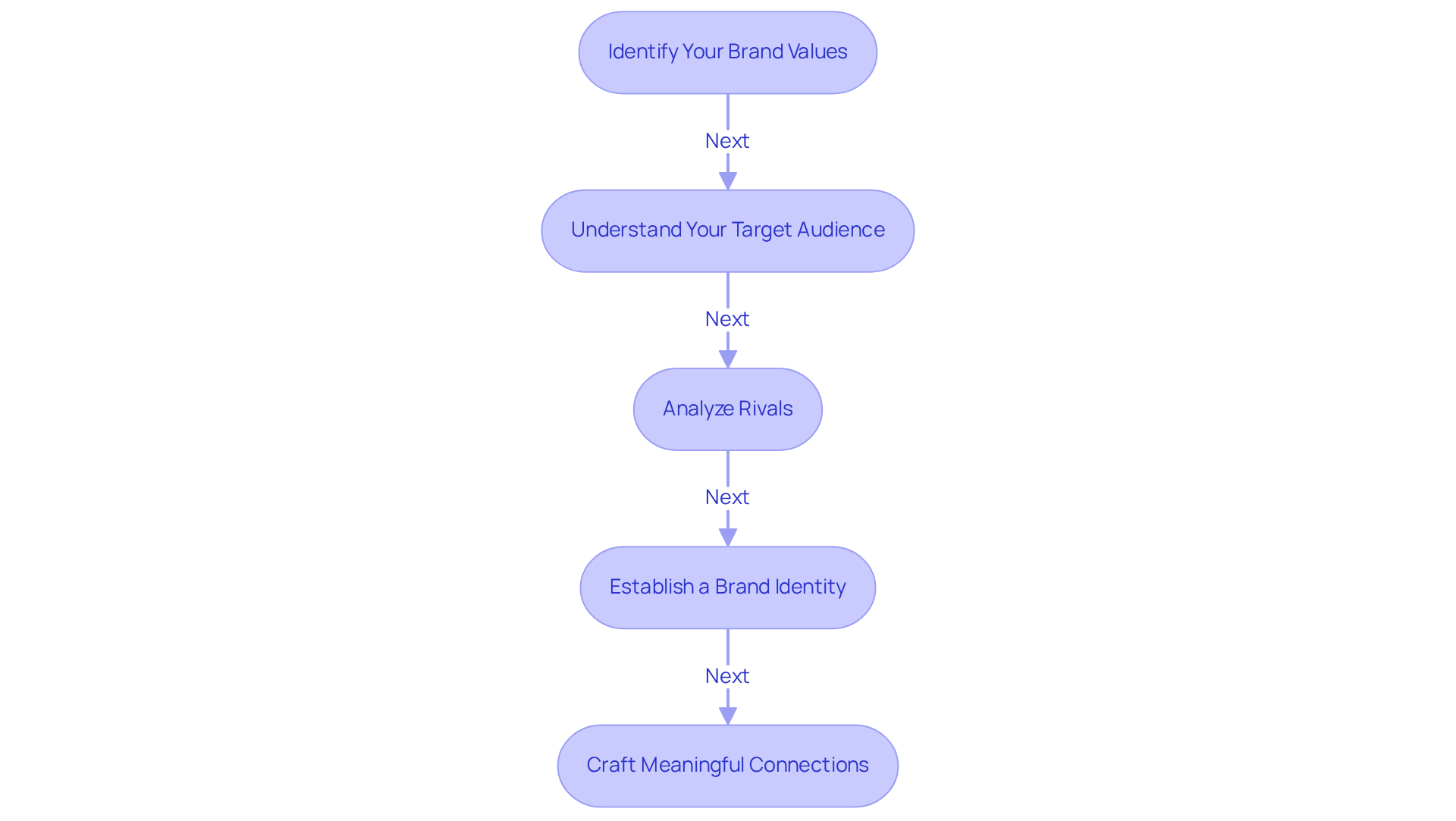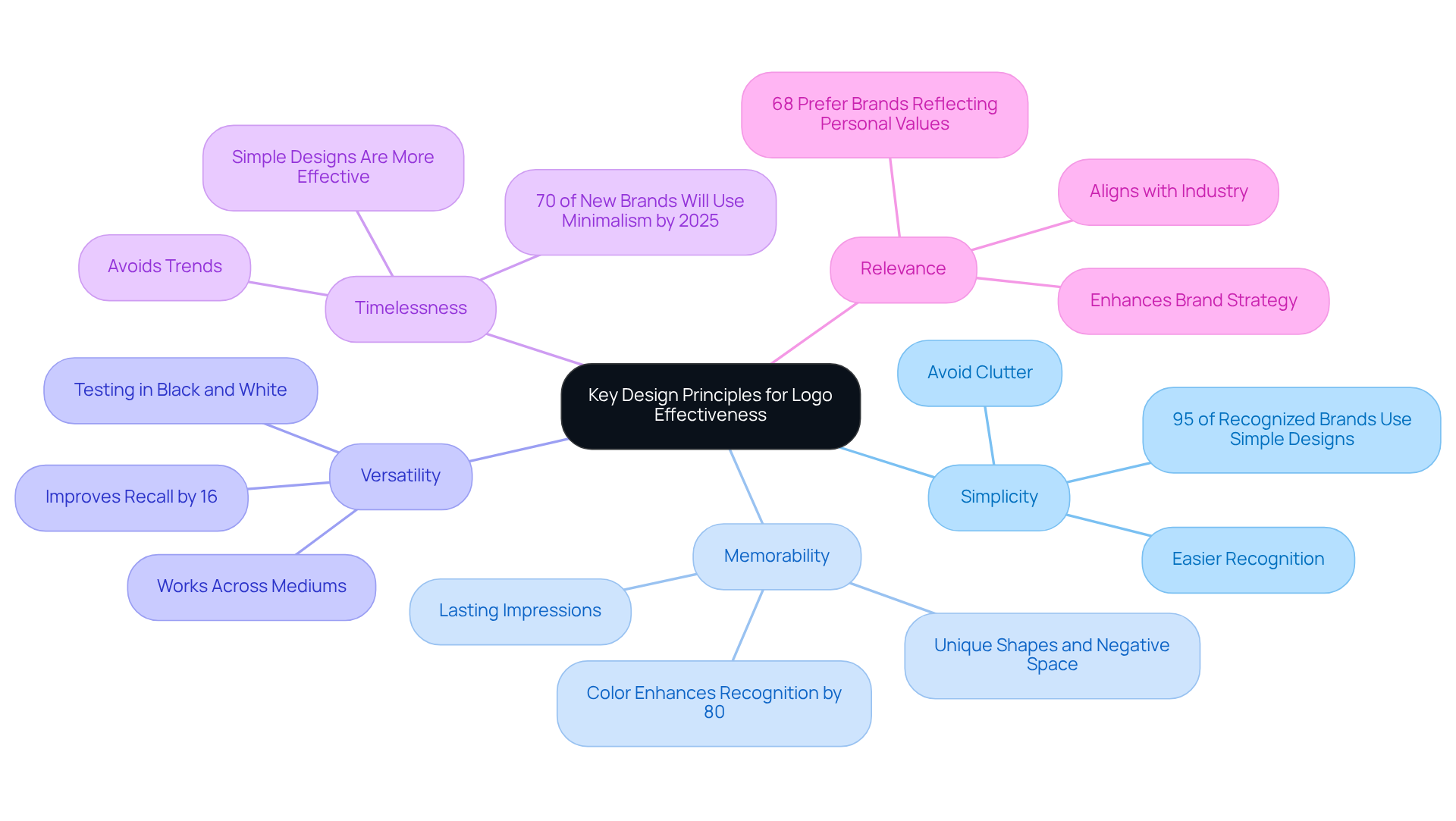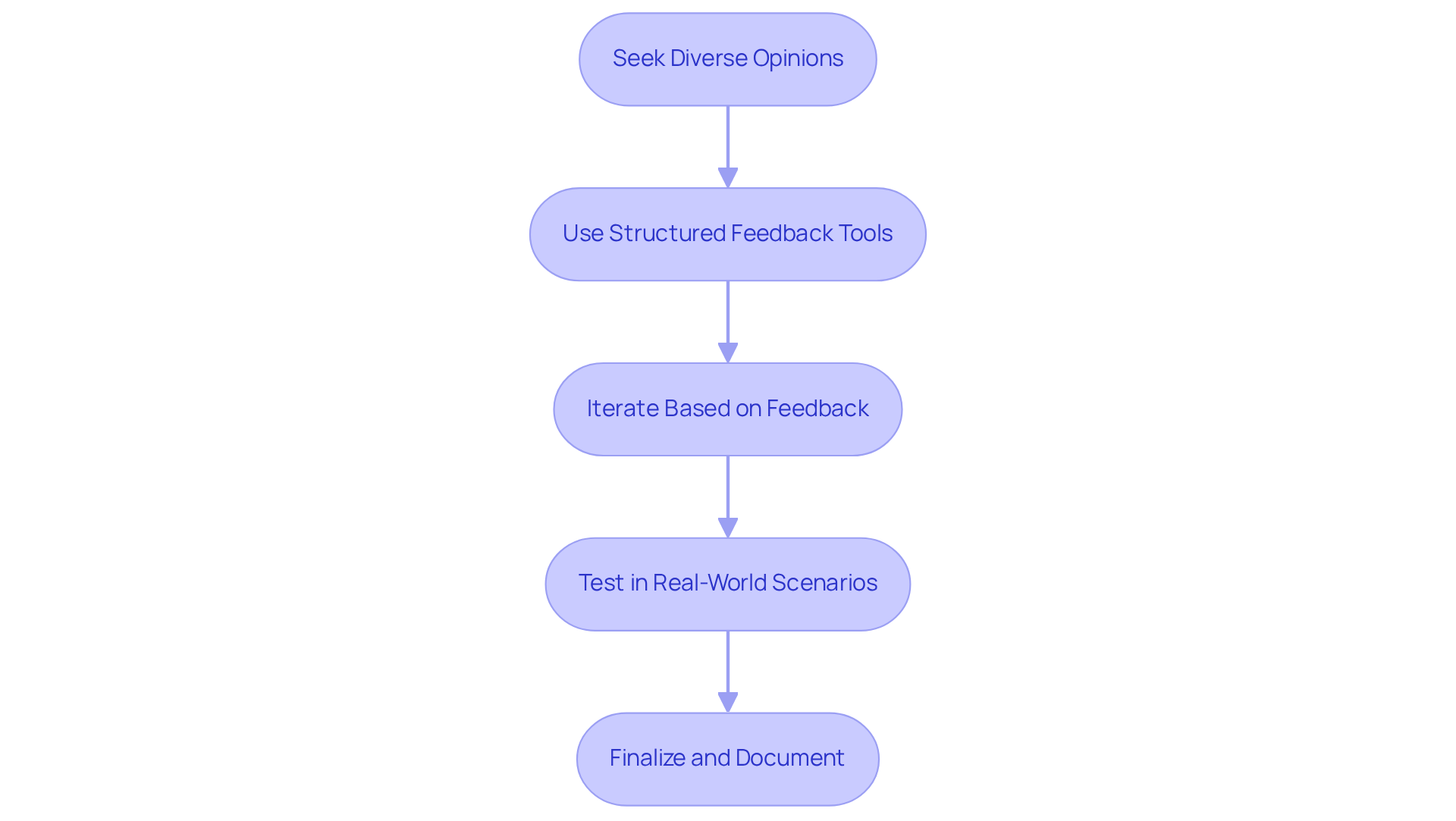Overview
Creating an effective brand logo can feel overwhelming for many startup founders. You might struggle with defining your brand identity or feel lost in the design process. These challenges can lead to frustration and uncertainty about how to connect with your audience. However, there’s a way forward.
By following a structured design process, applying key design principles, and gathering feedback, you can refine your logo to truly reflect your brand's core values. Remember, aligning your logo with what your audience cares about not only enhances its effectiveness but also fosters a deeper connection.
Statistics show how impactful thoughtful design can be on consumer perception and brand loyalty, reinforcing the importance of this journey. Together, we can navigate these steps and create a logo that resonates with both your brand and your audience's heart.
Introduction
Creating a compelling brand design logo is more than just an artistic endeavor; it serves as the visual anchor for a company's identity and values. Many startup founders face the challenge of making their brand stand out in a crowded marketplace. As consumers increasingly prioritize authenticity, this can feel overwhelming.
Understanding the essential steps in logo creation can empower businesses to forge deeper connections with their audience, but how can one navigate the complexities of brand identity? It's crucial to ensure that your logo not only stands out but also resonates meaningfully with consumers.
By focusing on these aspects, we can help you find a path that not only alleviates your concerns but also nurtures your vision.
Define Your Brand Identity
Designing a successful brand design logo can feel daunting, especially when you want it to accurately reflect your identity. It’s essential to recognize that your brand design logo embodies your core values, mission, and unique selling points. Let’s explore some steps together to ease this process:
- Identify Your Brand Values: Begin by reflecting on the principles that guide your business. These values should resonate throughout your identity. Remember, 77% of consumers prefer companies that align with their values, significantly influencing their purchasing decisions. It’s about finding that connection.
- Understand Your Target Audience: Think about who you want to reach. Gaining insight into your audience allows you to tailor your design to their preferences and expectations, enhancing its impact. You’re not just creating an emblem; you’re speaking directly to them.
- Analyze Rivals: Take a moment to examine symbols from similar companies. This can help you identify effective elements and areas where you can stand out. It’s important to note that 55% of first impressions hinge on visual elements, so ensuring your emblem is distinctive is crucial.
- Establish a Brand Identity: Consider how you want your identity to be perceived—whether it’s playful, serious, innovative, or traditional. This persona will guide your brand design logo choices, ensuring that they align with your values and mission.
Looking ahead to 2025, the importance of aligning visual identity with organizational values will only grow. Consumers are increasingly seeking authenticity and transparency from the companies they choose to support. By embracing this journey, you’re not just designing an emblem; you’re crafting a meaningful connection with your audience.

Follow a Step-by-Step Logo Design Process
Establishing an effective brand identity, including a strong brand design logo, can often feel overwhelming, especially for tech startup founders navigating a competitive landscape. At RNO1, we understand the challenges you face and believe that a brand design logo-focused approach is essential at every interaction point. Let’s explore how you can streamline your logo creation process with care and intention:
- Research and Inspiration: Begin by gathering ideas from various sources—be it creative websites, the beauty of nature, or inspiring art. Creating a mood board can help visualize your thoughts and guide you toward a cohesive direction. Research indicates that 49% of businesses consider aesthetics crucial for success, underscoring the importance of this foundational step. At RNO1, we prioritize aesthetics as a means to enhance market appeal through our Return On Design & Digital (RODD) strategies.
- Sketch Ideas: Allow yourself the freedom to explore with rough sketches. This phase encourages creativity without limitations, enabling you to discover unique elements that resonate with your identity. Our dedicated team at RNO1 is passionate about crafting meaningful designs that enhance your brand design logo.
- Digitalize Your Concepts: Transform your best sketches into digital formats using design software. Experiment with colors, fonts, and layouts—remember, color can boost brand recognition by up to 80%. This crucial experimentation phase reflects RNO1's commitment to solutions that incorporate a brand design logo, aligning with your vision and our RODD strategies.
- Create Variations: Develop multiple designs to explore different aesthetics and functionalities. Analyzing these variations can provide insight into consumer preferences; after all, 72% of consumers believe that a symbol's appearance significantly influences their loyalty. Additionally, businesses with well-crafted emblems can experience revenue growth of up to 33%. This highlights the importance of investing in high-quality branding and brand design logo, a principle we wholeheartedly support at RNO1.
- Complete Your Design: Choose the most compelling design and refine it to ensure it aligns with your identity. A well-crafted brand design logo should be versatile, adaptable across various mediums, and easily recognizable on different platforms. Companies that optimize their symbols for mobile responsiveness have seen a 15% increase in user engagement. This final step solidifies your company's visual presence in a competitive market. Furthermore, 83% of consumers believe a brand refresh should reflect its core values, emphasizing the need for coherence with your brand design logo, which is a fundamental aspect of RNO1's creative philosophy.
We invite you to share your experiences and thoughts as you embark on this journey. Remember, at RNO1, we are here to support you every step of the way.
Apply Key Design Principles for Effectiveness
Incorporating key design principles can significantly enhance your logo's effectiveness, and we understand how daunting this task can feel. Many founders struggle with creating a logo that truly reflects their vision and resonates with their audience. This challenge can lead to frustration and uncertainty about brand identity. At RNO1, we are here to guide you through this process with compassion and expertise.
-
Simplicity: A straightforward design is not just easier to recognize; it’s also easier to remember. Research shows that 95% of the world’s most recognized brands embrace simple designs, making them more memorable and effective. By avoiding clutter and focusing on essential elements, your logo can stand out and reflect RNO1's commitment to design-driven solutions.
-
Memorability: We encourage you to strive for a creation that leaves a lasting impression. Unique shapes or clever use of negative space can make a difference. Did you know that logos that effectively use color can enhance recognition by up to 80%? This makes memorability a crucial aspect of design. At our company, we believe that a memorable symbol is vital for maximizing brand marketability through our Return On Design & Digital (RODD) strategies.
-
Versatility: It’s essential to ensure your logo works seamlessly across various mediums and sizes, from business cards to billboards. Testing it in both black and white and color is crucial. Logos designed with flexibility in mind can improve customer recall by as much as 16% compared to more intricate styles, aligning beautifully with RNO1's aesthetic-focused ethos.
-
Timelessness: Aim for a creation that won’t quickly become outdated. Trends can be tempting, but they may not stand the test of time. By 2025, it is expected that 70% of new brands will adhere to minimalistic principles, underscoring the importance of timelessness in your branding. A compelling case study shows that simple designs are more effective in identity recognition, a principle that RNO1 proudly advocates in our design philosophy.
-
Relevance: Your emblem should resonate with your industry and connect with your target audience. Companies that align their identity with consumer values foster deeper connections; in fact, 68% of US adults prefer companies that reflect their personal values. RNO1's design approach ensures that your emblem not only meets these criteria but also enhances your overall brand strategy.
We understand that the journey of designing a logo can be overwhelming, but we are here to support you every step of the way. Let’s work together to create a logo that embodies your vision and resonates with your audience.

Gather Feedback and Refine Your Design
Once you have a draft of your logo, gathering feedback is crucial for refining your design. Many founders face the challenge of ensuring their emblem resonates well with their audience. The fear of missing out on valuable insights can be daunting, but there's a way forward that can truly enhance your design.
-
Seek Diverse Opinions: It’s important to share your emblem with a variety of stakeholders, including team members, potential customers, and industry peers. Diverse perspectives can reveal insights that enhance the design's effectiveness. Research indicates that brands prioritizing diverse feedback see a 20% increase in brand value, highlighting how vital varied viewpoints are in the feedback process.
-
Use Structured Feedback Tools: Implementing surveys or feedback forms can simplify the feedback process. By asking focused questions regarding the design's effectiveness and attractiveness, you can gather measurable insights that inform enhancements. A case study on measuring and interpreting branding metrics illustrates how structured feedback can effectively guide creative decisions.
-
Iterate Based on Feedback: Analyzing feedback allows you to identify common themes and areas for improvement. Incorporating A/B testing principles can help enhance branding visuals based on data-driven insights. Iterative design methods that include varied perspectives often lead to symbols that connect more profoundly with audiences, as case studies show that companies with iterative feedback loops experience a 30% rise in customer loyalty.
-
Test in Real-World Scenarios: Visualizing how the emblem performs across various contexts—like merchandise, websites, and social media—ensures versatility and effectiveness, which are essential for maintaining identity recognition. The Statsig Team emphasizes that a symbol's ability to convey the brand's message effectively is vital during this testing phase.
-
Finalize and Document: Once you’ve refined your brand design logo, it’s time to finalize it and create a comprehensive style guide that outlines its usage, including color codes, typography, and spacing guidelines. This documentation is essential for maintaining consistency across all platforms, which can boost revenue by up to 23%, as noted by branding professionals. Remember, you’re not alone in this journey; every step taken towards refining your logo is a step towards building a stronger brand identity.

Conclusion
Creating a logo that truly embodies your brand's identity and values can feel daunting. Many founders grapple with the challenge of ensuring their logo stands out while forging a genuine connection with their audience. This journey is not just about visual appeal; it's about crafting a meaningful representation of who you are as a brand. The implications of a well-designed logo are profound, as it shapes how consumers perceive and engage with your mission.
Key steps such as:
- Identifying your brand values
- Understanding your target audience
- Applying essential design principles
are crucial. These elements ensure that your logo is not only memorable but also versatile and timeless. Gathering diverse feedback is invaluable; it refines your design to align more closely with consumer expectations and preferences. Each phase of this process contributes to building a strong brand identity, which can foster loyalty and drive growth.
Ultimately, the significance of a thoughtfully crafted logo extends far beyond aesthetics; it serves as a powerful testament to your brand's mission and values. As consumers increasingly seek authenticity and alignment with their beliefs, investing time and effort into the logo creation process becomes vital. Embrace this opportunity to create a logo that captures attention and tells your brand's story, inviting your audience to engage with your vision and values. Together, let's embark on this journey to create something truly special that resonates deeply with your community.
Frequently Asked Questions
What is the purpose of a brand design logo?
A brand design logo embodies your core values, mission, and unique selling points, reflecting your identity to your audience.
How can I identify my brand values?
Begin by reflecting on the principles that guide your business. These values should resonate throughout your identity and connect with your audience.
Why is understanding my target audience important?
Gaining insight into your target audience allows you to tailor your design to their preferences and expectations, enhancing the logo's impact.
How can analyzing rivals help in designing my logo?
Examining symbols from similar companies can help you identify effective elements and areas where you can stand out, ensuring your emblem is distinctive.
What factors should I consider when establishing my brand identity?
Consider how you want your identity to be perceived—whether playful, serious, innovative, or traditional—as this persona will guide your logo design choices.
How is the importance of visual identity expected to change by 2025?
By 2025, the alignment of visual identity with organizational values will grow in importance, as consumers increasingly seek authenticity and transparency from companies.




